I’ll admit to being fairly naïve when I first started going to waterfalls. I assumed that waterfalls always had water… falling. Hence the name.
Boy, was I wrong, and nothing told me that more than the first time I took my family on a mile plus long hike and the boys were asking, “Are we there yet?” We knew the hike was supposed to be about a mile long, and so we had to be getting close when we came across a bridge. I told my wife, “I have a bad feeling about this,” as I looked down at the rocks we were crossing over.
She asked what I meant, and I told her that the rocks were smooth. “I think this is a river bed… just no water.” And, unfortunately, I was right.
This is when I found out there are Year Round Waterfalls, like I was used to, and then there were waterfalls that only occur during certain seasons, or after a rain – often called Wet Weather Waterfalls.
Both are undeniably stunning, but they hold their own unique charm and appeal. However, as I looked at that “waterfall,” I was not in awe of it. I wish I had been, for as when we crossed over the bridge, I could see that when it had water, it would be over 20 feet across and 40 or more feet tall. It would have been impressive.
In this article, we will delve into the world of waterfalls and compare the awe-inspiring beauty of year round waterfalls with the dynamic allure of wet weather waterfalls.
What Makes Year Round Waterfalls Special?
Year round waterfalls have a certain enchantment that sets them apart from their seasonal counterparts. The constant flow of water creates a symphony of soothing sounds that instantly transports you to a state of tranquility.
These majestic natural wonders, surrounded by lush green vegetation, provide a haven for a diverse range of flora and fauna. The continuous cascade of water brings life to the surroundings, offering a refreshing retreat for both humans and wildlife alike.
One thing that truly sets them apart is when it is in freezing temperatures and the waterfall freezes. This creates an almost magical experience looking at the once moving water frozen into place. Please note that reaching frozen waterfalls in many cases should only be attempted with the proper equipment as the trails can be very slippery and there many not be help or cell reception to call for help available.
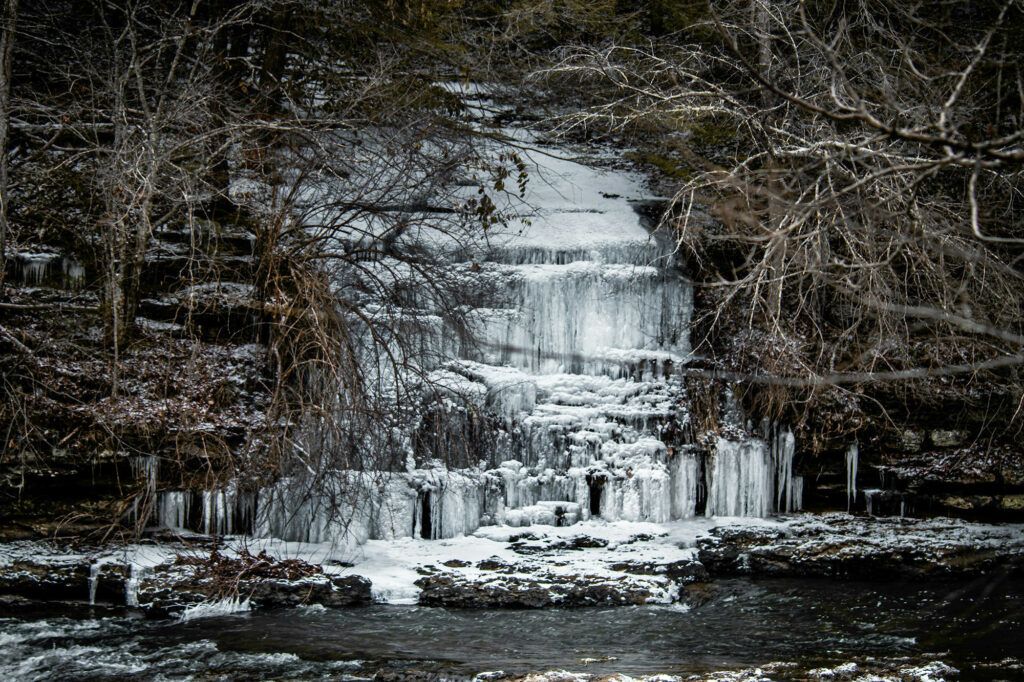
One of the remarkable aspects of year round waterfalls is their ever-changing appearance. The water’s constant flow shapes the rocks over time, creating striking formations that add to the waterfall’s allure.
Waterfalls, like Linville Falls, start a gorge that goes on for many miles as the river cuts through the rocks over many thousands of years.
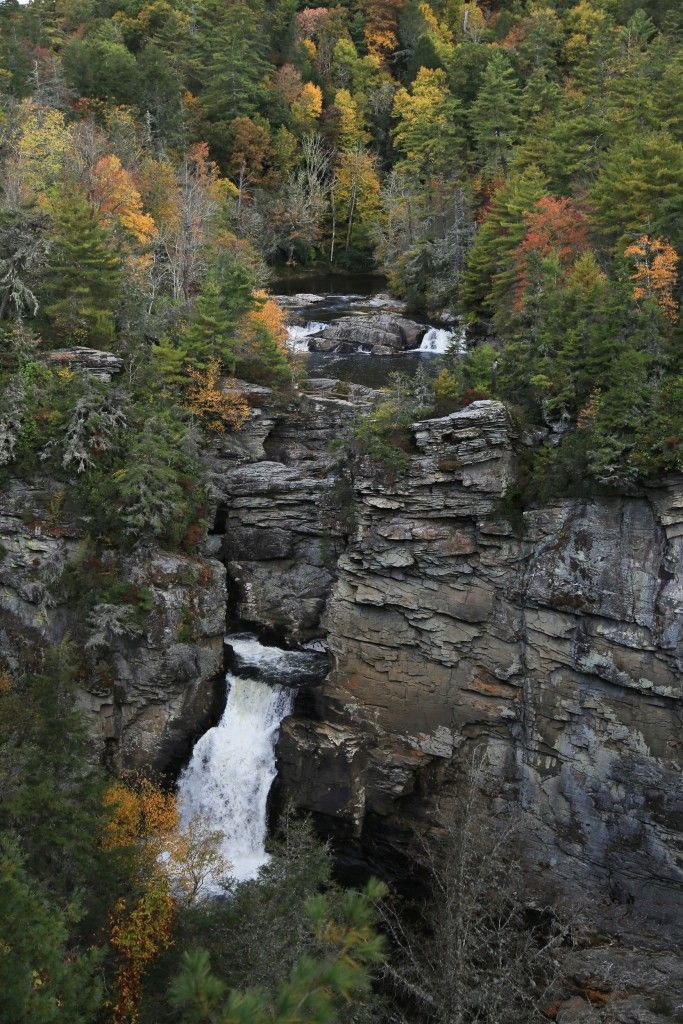
The wet mist that accompanies year round waterfalls adds to the experience. This natural phenomenon not only enhances the beauty of the waterfall, but it also creates a micro-climate around it. It promotes the growth of unique plant species that thrive in this moist environment.
These waterfalls have become popular tourism destinations. They attract visitors from all over the world who seek to immerse themselves in the beauty and serenity of nature. That is why we started visiting them.
Both Linville Falls, mentioned above, and Cumberland Falls have hiking trails, gift shops, and more that you can see when you visit. They are also busy year round because the water never stops flowing (although it may be heavier during the rainy season).
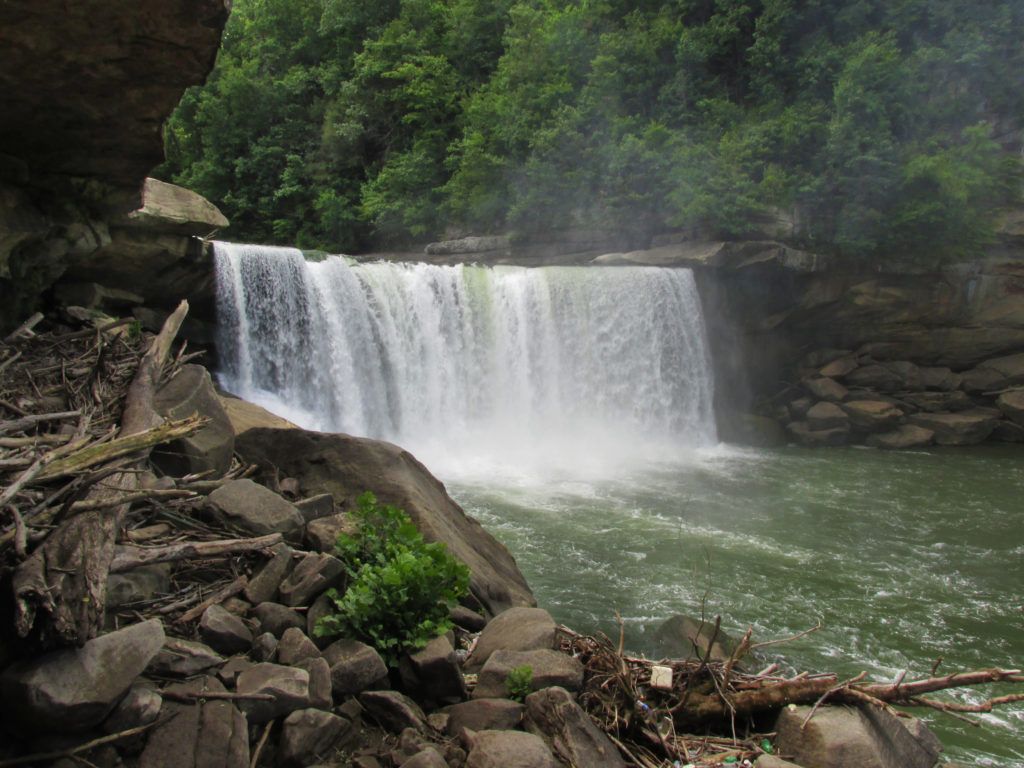
Definition and Characteristics of Year Round Waterfalls
Year round waterfalls are a breathtaking natural phenomenon that showcase the beauty of nature in its purest form. They will maintain a near consistent flow throughout the year, regardless of the changing seasons.
These majestic cascades result from several factors, including geology, climate, and hydrology.
One key characteristic of year round waterfalls is their ability to maintain a good flow of water throughout the year. This is often because of a reliable water source, such as a spring, river, or underground aquifer.
It ensures a steady supply of water, even during dry seasons when other waterfalls might run dry. The consistent flow adds to the allure of these waterfalls, creating a mesmerizing spectacle for all who witness it.
These waterfalls often become important habitats for various flora and fauna, serving as a source of freshwater and shelter for many species.
Sources of Water
One of the most reliable sources of water for year round waterfalls is groundwater. Groundwater refers to the water that collects beneath the Earth’s surface in aquifers.
Rainwater and snow melt replenish these underground water reservoirs, ensuring a constant supply of water for the waterfall. Groundwater-fed waterfalls have a good flow throughout the year, as they are not solely reliant on surface runoff.
Further north, another source that contributes to year round waterfalls is glacier melt water. In areas with glaciers, the melting of ice and snow provides a consistent water supply even during dry seasons. However, do not expect to see them in the southeast.
Rivers and streams are also significant sources of water for year round waterfalls. These water bodies act as natural conduits, carrying water from higher elevations to lower ones.
This is especially true if multiple rivers and streams all feed into a primary water source that feeds the waterfall.
These waterfalls are often located in valleys or canyons, where the stream or river cascades over cliffs or boulders, creating stunning and continuous water displays.
Wet Weather Waterfalls
Definition and Characteristics
Wet weather waterfalls are a mesmerizing natural phenomenon that many outdoor enthusiasts seek out. However, because they don’t run year round, it feels like finding treasure when you find one.
Unlike the year round waterfalls, wet weather waterfalls flow best during periods of rain or snow melt, making the best time to view them in the late winter/spring months. This unique characteristic adds a sense of exclusivity to these falls, making them a favorite among adventure seekers.
This also means that during dry seasons, these falls may be reduced to a trickle or even go completely dry, only to come alive during periods of heavy rainfall.
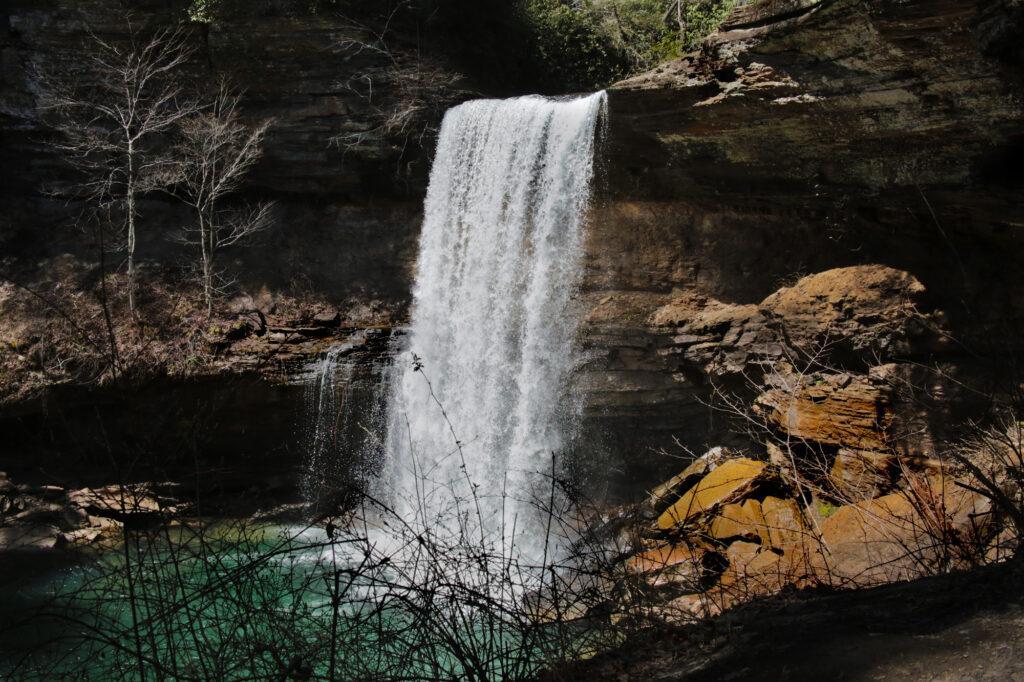
Notice how how much more water is available during the spring than the fall. Luckily, the beauty of the fall colors still make it a worthy hike to consider.
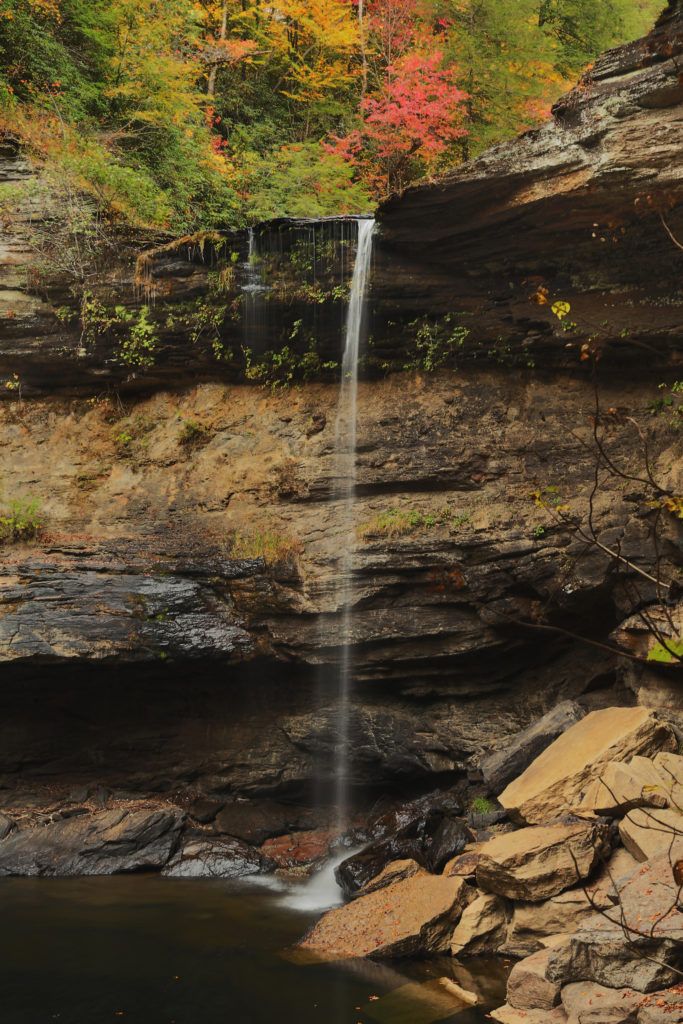
This unpredictability makes the experience of witnessing these cascades even more exciting.
Another key characteristic is the enhanced natural beauty that wet weather waterfalls exhibit.
The abundance of water during rainy periods creates a dramatic display of rushing water, resulting in a powerful and breathtaking sight. The sheer force of the water crashing down adds an element of intensity, making wet weather waterfalls a sight to behold.
Finally, wet weather waterfalls often offer a more secluded and serene setting compared to their year round counterparts.
Because their flow depends on the weather, these falls are often in remote locations, away from the usual tourist crowds.
This exclusivity allows visitors to truly immerse themselves in nature, appreciating both the beauty of the waterfall and the tranquility of the surroundings.
Wet weather falls will be more likely to have animals in the vicinity, as they are not used to having people around.
Geological and Environmental Factors Influencing Waterfall Types
Did you know that different geological and environmental factors can influence the types of waterfalls that exist?
Of course, one crucial factor is water flow. This is determined by precipitation patterns and geographic features.
Year round waterfalls are those that flow consistently throughout the year, regardless of the weather. The stable water flow allows for the formation of a consistent cascade, creating a mesmerizing sight for onlookers.
On the other hand, wet weather waterfalls depend on rainfall. That means these waterfalls are found in areas with seasonal rainfall patterns or in regions where the geology allows for the temporary accumulation and release of water.
Wet weather waterfalls can vary greatly in size and intensity depending on the amount of rainfall, creating a dynamic and ever-changing display of nature’s power.
Geological features also play a crucial role in determining the type of waterfall that forms.
Steeper slopes and rocky terrain can cause tall, narrow waterfalls with powerful vertical drops. In contrast, more gradual slopes with softer rock layers can lead to wider, cascading waterfalls with gentle drops.
Different rock types can also impact waterfall formation, as some rocks are more resistant to erosion than others. This results in unique shapes and formations.
Other Man-made Factors
Dams can effect the water flow of a river, and cause a waterfall to either appear, or disappear in some instances. For example, Dolan Branch Falls, located in Bays Mountain Park is off a waterway, connected to a dam.
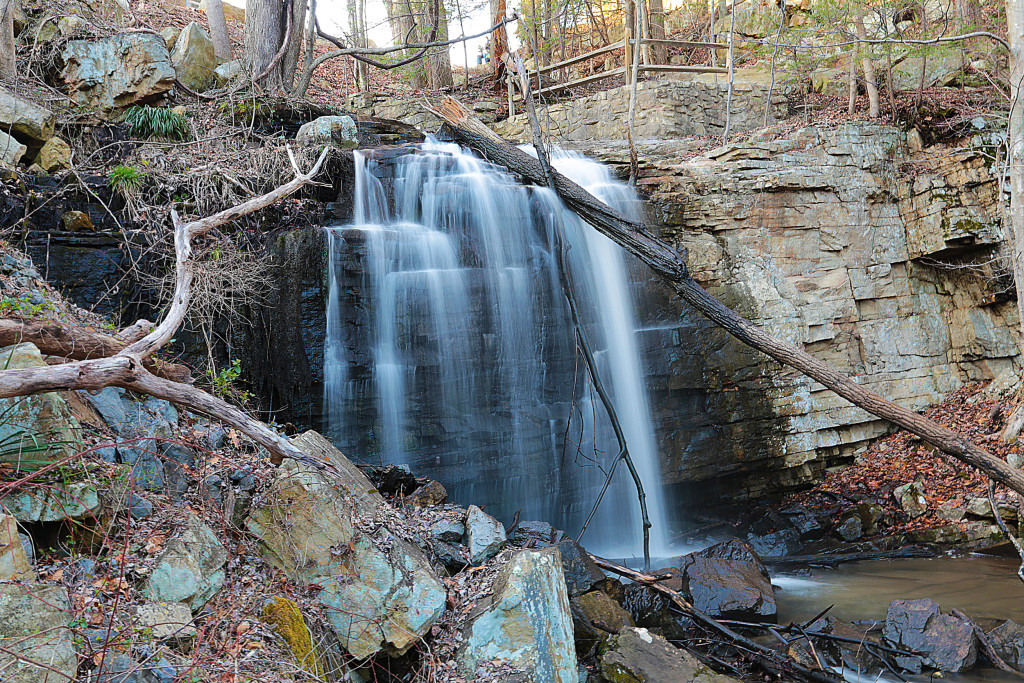
When the dam is set to release water, due to high water levels, the waterfall flows. However, if the water levels do not require spillage, there is no water for the waterfall. Without the dam, it would be dependent upon the natural water flowing through the area, but with the dam, it is controlled by people.
It is logical to assume that the water overflowing the dam, would create the waterfall naturally if the water was sufficient to flow freely. It’s just easier to tell if you should take the short, easy hike to see the waterfall based upon if you see water cresting the dam.
Another instance, which is more rare, is when people will add (pipe in) water to a waterfall to make it more impressive. Yuntai Waterfall, in China, has recently been shown to pipe additional water in. According to officials, “(They) cannot guarantee to meet the public in its most beautiful appearance due to season changes.” They added that the waterfall had “a tiny improvement during dry season.” – external link to CNN
This changes the ecological nature of the waterfall, and we believe it should be left as is, to prevent changes to the area flora and fauna.
Ecological Significance of Different Waterfall Types
Waterfalls are not only breathtakingly beautiful, but they also play a crucial role in the ecological system.
Different types of waterfalls have different ecological significance, with variations in their water flow throughout the year.
Year Round Waterfalls
These waterfalls serve as important habitats for many aquatic species, supporting a diverse ecosystem.
The constant flow of water provides a stable environment for fish, amphibians, and other wildlife. The water ensures their survival and allows for breeding and reproduction.
The continuous water flow also helps in maintaining water quality by preventing stagnation and promoting the circulation of nutrients.
Wet Weather Waterfalls
On the other hand, despite their fleeting nature, wet weather waterfalls have their own ecological significance.
During heavy rainfall, these cascades contribute to the replenishment of groundwater and the overall water cycle. They also contribute to soil erosion control by redistributing water and preventing sediment buildup.
How Can I Tell if a Waterfall is a Wet Weather Waterfall Online?
The best way to tell if a waterfall is a wet weather waterfall is to do a search of the waterfall. Look at the photos if they always have a lush green background then there is a good chance that this is a wet weather waterfall. Look for waterfalls with leaves that have changed color in the fall and then look at the waterfall itself, does it match the photos with the lush green foliage surrounding it?
Conclusion
We hope this information was helpful to you. Since we didn’t know about year round vs wet weather waterfalls, we didn’t initially put that information into our descriptions. However, as we find out about this information, we try to add it to the descriptions of our waterfalls.
I never thought about this. I just thought they always looked the same. Thanks for the tip.